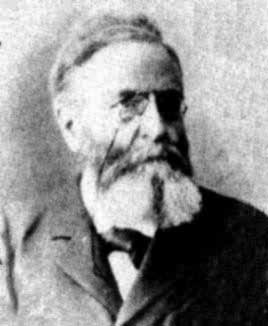

تاريخ الرياضيات

الاعداد و نظريتها

تاريخ التحليل

تار يخ الجبر

الهندسة و التبلوجي


الرياضيات في الحضارات المختلفة

العربية

اليونانية

البابلية

الصينية

المايا

المصرية

الهندية


الرياضيات المتقطعة

المنطق

اسس الرياضيات

فلسفة الرياضيات

مواضيع عامة في المنطق


الجبر

الجبر الخطي

الجبر المجرد

الجبر البولياني

مواضيع عامة في الجبر

الضبابية

نظرية المجموعات

نظرية الزمر

نظرية الحلقات والحقول

نظرية الاعداد

نظرية الفئات

حساب المتجهات

المتتاليات-المتسلسلات

المصفوفات و نظريتها

المثلثات


الهندسة

الهندسة المستوية

الهندسة غير المستوية

مواضيع عامة في الهندسة

التفاضل و التكامل


المعادلات التفاضلية و التكاملية

معادلات تفاضلية

معادلات تكاملية

مواضيع عامة في المعادلات


التحليل

التحليل العددي

التحليل العقدي

التحليل الدالي

مواضيع عامة في التحليل

التحليل الحقيقي

التبلوجيا

نظرية الالعاب

الاحتمالات و الاحصاء

نظرية التحكم

بحوث العمليات

نظرية الكم

الشفرات

الرياضيات التطبيقية

نظريات ومبرهنات


علماء الرياضيات

500AD

500-1499

1000to1499

1500to1599

1600to1649

1650to1699

1700to1749

1750to1779

1780to1799

1800to1819

1820to1829

1830to1839

1840to1849

1850to1859

1860to1864

1865to1869

1870to1874

1875to1879

1880to1884

1885to1889

1890to1894

1895to1899

1900to1904

1905to1909

1910to1914

1915to1919

1920to1924

1925to1929

1930to1939

1940to the present

علماء الرياضيات

الرياضيات في العلوم الاخرى

بحوث و اطاريح جامعية

هل تعلم

طرائق التدريس

الرياضيات العامة

نظرية البيان
Heinrich Martin Weber
المؤلف:
B Schoeneberg
المصدر:
Biography in Dictionary of Scientific Biography
الجزء والصفحة:
...
26-1-2017
906
Died: 17 May 1913 in Strasbourg, Germany (now France)

Heinrich Weber was born in Heidelberg, the son of G Weber who was an historian. He entered the University of Heidelberg in 1860 but, as was the common practice of German students at this time, he spent part of his time studying at a different university. For Weber it was the University of Leipzig that he moved to in the middle of his studies, spending a year there before returning to Heidelberg to complete his education. He was awarded a doctorate from the University of Heidelberg in 1863.
In order to become a university teacher, Weber needed to write a further thesis, his habilitation thesis. He went to Königsberg where he studied under Franz Neumann and Friedrich Richelot, who had been a student of Jacobi. Although Jacobi had died over ten years before Weber began his studies at Königsberg, his influence was still strongly felt and it would not be unreasonable to say that Weber, through his teachers at Königsberg, was strongly influenced by Jacobi's style of mathematics. There were other students at Königsberg at this time who would become important in the development of mathematics, in particular Wangerin studied for his doctorate around the same time as Weber worked for his habilitation.
In 1866 Weber's habilitation thesis was accepted and he became a privatdozent at Heidelberg in that year. Three years later he was appointed as extraordinary professor at Heidelberg. Over the next twenty-five years, Weber taught at a number of different institutions. He taught in Zurich at the Eidgenössische Polytechnikum, at the University of Königsberg, and at the Technische Hochschule in Charlottenburg. His final post was in Strasbourg where he was appointed in 1895.
The city of Strasbourg was German at this time (and called Strassburg) and it had been since it was annexed by Germany during the Franco-Prussian War of 1870-71. Weber remained in Strasbourg for the rest of his life and during this time it remained a German city; only at the end of the World War I in 1918 did the city revert to France
Weber's main work was in algebra, number theory, analysis and applications of analysis to mathematical physics. This seems a contradiction in terms, for we have now almost said that Weber's main work spans the whole spectrum of mathematics. In fact this is not far from the truth for Weber work was characterised by its breadth across a wide range of topics.
To a certain extent this breadth can be attributed to the various influences on Weber from colleagues around him. The applications to mathematical physics certainly grew from working with Franz Neumann in Königsberg. But in Königsberg there was also the Jacobi influence, particularly coming through one of his other teacher Friedrich Richelot, which saw Weber doing important work on algebraic functions.
Perhaps Weber is best known for his outstanding text Lehrbuch der Algebra published in 1895 and it is his work in algebra and number theory for which he is best known. If he was influenced by his colleagues to work in different areas of mathematics then it is a very fair question to ask where the influence came from which prompted Weber to work on algebra and number theory. The answer must be Dedekind. He wrote an important paper with Dedekind in 1882 in which they examined algebraic functions from an algebraic rather than analytic point of view.
Weber's Lehrbuch der Algebra is an outstanding work but, although he tried hard to connect the various algebraic theories, even fundamental concepts such as a field and a group are only seen as tools and not properly developed as theories in their own right. It was, however, a remarkable book which was effective over many years as a teaching tool. In fact [1]:-
Weber was an enthusiastic and inspiring teacher who took great interest in educational questions.
- B Schoeneberg, Biography in Dictionary of Scientific Biography (New York 1970-1990).
http://www.encyclopedia.com/doc/1G2-2830904577.html
Books:
- Festschrift Heinrich Weber zu seinem siebzigsten Geburtstag am 5. März 1912 (New York, 1971).
Articles:
- G Frei, Heinrich Weber and the emergence of class field theory, The history of modern mathematics I (Boston, MA, 1989), 425-450.
- A Voss, Heinrich Weber, Jahresberichte der Deutschen Mathematiker-Vereinigung 23 (1914), 431-444.
 الاكثر قراءة في 1840to1849
الاكثر قراءة في 1840to1849
 اخر الاخبار
اخر الاخبار
اخبار العتبة العباسية المقدسة

الآخبار الصحية















 قسم الشؤون الفكرية يصدر كتاباً يوثق تاريخ السدانة في العتبة العباسية المقدسة
قسم الشؤون الفكرية يصدر كتاباً يوثق تاريخ السدانة في العتبة العباسية المقدسة "المهمة".. إصدار قصصي يوثّق القصص الفائزة في مسابقة فتوى الدفاع المقدسة للقصة القصيرة
"المهمة".. إصدار قصصي يوثّق القصص الفائزة في مسابقة فتوى الدفاع المقدسة للقصة القصيرة (نوافذ).. إصدار أدبي يوثق القصص الفائزة في مسابقة الإمام العسكري (عليه السلام)
(نوافذ).. إصدار أدبي يوثق القصص الفائزة في مسابقة الإمام العسكري (عليه السلام)


















